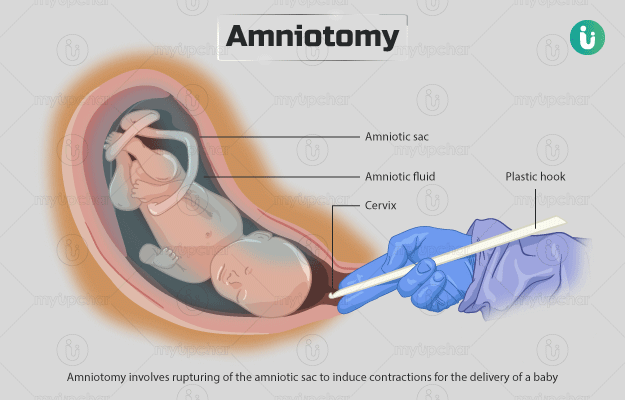Summary
Amniotomy involves rupturing of the amniotic sac (a sac inside the uterus that contains amniotic fluid and protects the baby) to induce contractions for the delivery of a baby. The procedure is done in case of conditions such as an overdue pregnancy, health issues like high blood pressure in the mother, birth of more than one baby during the delivery, and slow growth of the baby. You will have to carry sanitary pads and things needed for the care of your baby to the hospital before delivery. The doctor will insert a small hook in your cervix that will break your amniotic sac and initiate contractions for the delivery. After the birth, you will need special care to manage pain, discomfort and bleeding issues before you can resume your regular activities.
- What is amniotomy?
- Why is amniotomy recommended?
- Who can and cannot get amniotomy?
- What preparations are needed before amniotomy?
- How is amniotomy done?
- How to care for yourself after amniotomy?
- What are the possible complications/risks of amniotomy?
- When to follow up with your doctor after an amniotomy?
What is amniotomy?
Amniotomy is also called artificial rupturing of the membrane or water breaking.
You will need to undergo several stages of labour when you are giving birth to your baby. Your cervix (the mouth of the womb or uterus) should be fully opened at 10 cm to deliver the baby. In the initial stage of the delivery, the cervix opens gradually and irregular contractions (the muscles of the uterus tighten up and then relax) are experienced. This is the lengthiest phase of labour. The process can be accelerated by using various methods. Amniotomy is one such method wherein the amniotic sac (the sac inside the womb which contains the amniotic fluid and protects and allows the baby to grow) is ruptured to remove the fluid surrounding the baby (amniotic fluid). Your contractions will become stronger after an amniotomy.
Read more: Normal delivery process
Why is amniotomy recommended?
A doctor may artificially induce labour for you if you or your baby are at risk due to conditions such as:
- Overdue pregnancy (more than 41 weeks) as the baby may develop health problems after 41 weeks
- In case of health conditions like diabetes, high blood pressure, or kidney problems in the mother
- Multiple births (if you are expecting more than one baby – twin birth or more)
- Placenta (the organ that provides oxygen and nutrients to the baby) is not functioning properly
- The growth of the baby has slowed down or the baby shows reduced movements or changes in the heart rate
- To place monitoring devices internally, for example, placing a fetal scalp electrode directly on the baby’s scalp, to monitor the baby.
Who can and cannot get amniotomy?
This surgery is not performed in women with the following conditions:
- Vasa previa or placenta previa
- Active herpes lesion
- Suspected velamentous insertion of the umbilical cord (a pregnancy complication in which the umbilical cord gets inserted into the placenta)
- HIV infection
- Malpresentation of the baby, e.g., transverse position
- Unengaged head of the baby (the head of the baby has not come down into the pelvis)
- If the woman is not in active labour (cervix is dilated only up to 6 cm)
- If the woman does not want any intervention
This procedure can be done with precautions in the presence of a senior doctor in case of:
- Polyhydramnios (Excessive collection of amniotic fluid)
- High presenting fetal part (the presenting part of the fetus has not yet come down into the pelvis, presenting part is the first part of the baby that comes out of the birth canal, it could be the head, feet, shoulder or buttocks)
What preparations are needed before amniotomy?
This surgery is a part of the childbirth process. You will need the following preparations before the delivery:
- Share information about all the medications that you take, including prescribed or non-prescribed medicines, herbs, minerals, vitamins, and supplements.
- You will be asked to carry large or maternity size sanitary pads to the hospital.
- Ask a friend or family member to accompany you to the hospital.
- Carry the following essentials for your baby:
- Disposable nappies
- Baby blanket
- Clothes
- Cleaning products like nappy wipes, cotton wool, or soap
- Carry a pair of loose-fitting clothes for your hospital stay.
- You will need to sign an approval or consent form to grant your permission for the surgery.
How is amniotomy done?
Preoperative preparation: Once you reach the hospital, the following preparations will be done:
- A nurse will examine your temperature, blood pressure, urine, and pulse rate.
- Your doctor will check your baby’s position and heartbeats.
- You will then have an internal examination, wherein a nurse will check the dilation of your cervix to assess whether the baby is coming out head first and confirm that the head of the baby has come down into your pelvis.
During the surgery: The doctor will perform the following steps:
- He/she will insert a small plastic hook inside your cervix towards the amniotic membrane.
- The doctor will catch the amniotic membrane with the hook and gently move the hook in the upward direction to make a tear in the membrane.
- This causes the amniotic sac to break, and the amniotic fluid should immediately start flowing from your vagina. A nurse will note the colour of your amniotic fluid, which should be clear and odourless.
- The pressure of your baby’s head over the cervix will gradually increase, leading to an increase in contractions.
- Sometimes, an artificial hormone is given immediately to induce contractions.
After amniotomy:
- Your temperature will be taken every two hours, and you will be checked for any symptoms of infection. Your baby’s heart rate will also be monitored.
- When your contractions increase, you will be asked to push so the baby can be delivered out of your vagina.
- The doctor will cut the umbilical cord and remove the placenta.
After the delivery, the nurse will check your heart rate, blood pressure, and the amount of vaginal bleeding. They may apply an ice pack to the swollen area between your vagina and anus (perineum). The doctor may prescribe a few pain medicines to reduce your discomfort after the delivery. You may be allowed to take a warm water bath one day after your delivery.
How to care for yourself after amniotomy?
Once you are home after your delivery, you will need to take the following care:
- Perineum care: The soreness over the perineal area can be reduced by:
- Soaking the perineum in warm water.
- Maintaining good hygiene by cleaning the area thoroughly each time you visit the washroom.
- Sitting on a doughnut-shaped cushion or pillow to keep the pressure off this area.
- Applying ice wrapped in a towel or ice pack over the perineum.
- Doing Kegel exercises to strengthen the pelvic area.
- Pain management:
- Your doctor may prescribe a few painkillers to reduce stomach cramps after the delivery.
- You may also have pain around your nipples for a few days. The doctor may suggest massaging the breast or applying a cream on your nipples to reduce the pain.
- Bleeding and vaginal discharge:
- Initially, you may have red-coloured discharge with blood clots for a few days. This will gradually reduce after a few weeks or months.
- You will have to use sanitary napkins until the discharge has completely stopped.
- Periods:
- You will get your periods again after six to eight weeks if you are not breastfeeding your baby.
- Activities:
- Avoid using the staircase or lifting heavy objects until advised by the doctor.
- You can resume your work partially, i.e., for a few hours or days a week.
- Sexual activities:
- The doctor may advise you to not have sexual relations until four to six weeks after delivery.
- You may have vaginal dryness for a while after delivery, for which you can use water-based lubricating gels during sexual intercourse.
Amniotomy can speed up the labour stage during the delivery. The use of this procedure, along with some hormonal supplements, can also reduce the chances of caesarean section (surgical procedure) for the birth of your baby.
When to see the doctor?
You must call or visit your doctor immediately if you experience the following symptoms:
- Fever of 100.4°F (38°C) or above
- Excessive bleeding (soaking more than one sanitary pad per hour), large clots, or increase in bleeding
- Swelling, tenderness, or pain in legs
- Chest pain
- Cough
- Nausea or vomiting
- Worsening of abdominal pain
- Foul-smell discharge from the vagina
- Redness, warmth, cracking, or bleeding from the nipples or area around it
- Painful urination
- Inability to control urination or a sudden urge to urinate
- Increased pain in the vaginal area
- Vision changes or headaches
- Depressed or suicidal feelings
- Hallucinations or any thoughts of harming your baby
What are the possible complications/risks of amniotomy?
This surgery is known to carry the following risks:
- Prolapse of the umbilical cord
- Fetal bradycardia (decrease in heartbeats of the baby) if the baby does not get enough oxygen
- Infection in the baby or you
- Need to perform an emergency cesarean section
When to follow up with your doctor after an amniotomy?
You will have a follow-up scheduled within one week of the surgery to check your healing.
Disclaimer: The above information is provided purely from an educational point of view and is in no way a substitute for medical advice by a qualified doctor.
Find Obstetrician and Gynaecologist in cities
- Obstetrician and Gynaecologist in Bangalore
- Obstetrician and Gynaecologist in Mumbai
- Obstetrician and Gynaecologist in Ghaziabad
- Obstetrician and Gynaecologist in Chennai
- Obstetrician and Gynaecologist in Pune
- Obstetrician and Gynaecologist in Delhi
- Obstetrician and Gynaecologist in Hyderabad
- Obstetrician and Gynaecologist in New Delhi
- Obstetrician and Gynaecologist in Gwalior
- Obstetrician and Gynaecologist in Gurgaon
Surgery Cost In Your City
Doctors for Amniotomy

Dr. Ayushi Gandhi
Obstetrics & Gynaecology
4 Years of Experience

Dr. Anjali
Obstetrics & Gynaecology
23 Years of Experience

Dr.Anuja Ojha
Obstetrics & Gynaecology
20 Years of Experience

Dr. Geeta Kulkarni
Obstetrics & Gynaecology
7 Years of Experience
References
- Mahdy H, Glowacki C, Eruo FU. Amniotomy. [Updated 2020 Aug 23]. In: StatPearls [Internet]. Treasure Island (FL): StatPearls Publishing; 2020 Jan
- National Health Service [Internet]. UK; The stages of labour and birth
- Hull University Teaching Hospitals [Internet]. NHS Foundation Trust. National Health Service. UK; Information about Induction of Labour
- Women and Newborn Health Service [Internet]. King Edward Memorial Hospital. Australia; Artificial rupture of membranes (ARM)
- Neumayer L, Ghalyaie N. Principles of preoperative and operative surgery. In: Townsend CM Jr, Beauchamp RD, Evers BM, Mattox KL, eds. Sabiston Textbook of Surgery: The Biological Basis of Modern Surgical Practice. 20th ed. Philadelphia, PA: Elsevier; 2017:chap 10
- Smith SF, Duell DJ, Martin BC, Aebersold M, Gonzalez L. Perioperative care. In: Smith SF, Duell DJ, Martin BC, Gonzalez L, Aebersold M, eds. Clinical Nursing Skills: Basic to Advanced Skills. 9th ed. New York, NY: Pearson; 2016:chap 26
- Isley MM, Katz VL. Postpartum care and long-term health considerations. In: Gabbe SG, Niebyl JR, Simpson JL, et al, eds. Obstetrics: Normal and Problem Pregnancies. 7th ed. Philadelphia, PA: Elsevier; 2017:chap 23
- Norwitz ER, Mahendroo M, Lye SJ. Physiology of parturition. In: Resnick R, Lockwood CJ, Moore TR, Greene MF, Copel JA, Silver RM, eds. Creasy and Resnik’s Maternal-Fetal Medicine: Principles and Practice. 8th ed. Philadelphia, PA: Elsevier Saunders; 2019:chap 6
- Nemours Children’s Health System [Internet]. Jacksonville (FL): The Nemours Foundation; c2017; Recovering From Delivery
- Counselling for Maternal and Newborn Health Care: A Handbook for Building Skills. Geneva: World Health Organization; 2013. 11, POSTNATAL CARE OF THE MOTHER AND NEWBORN
- Cleveland Clinic [Internet]. Ohio. US; Caring for Your Health After Delivery















